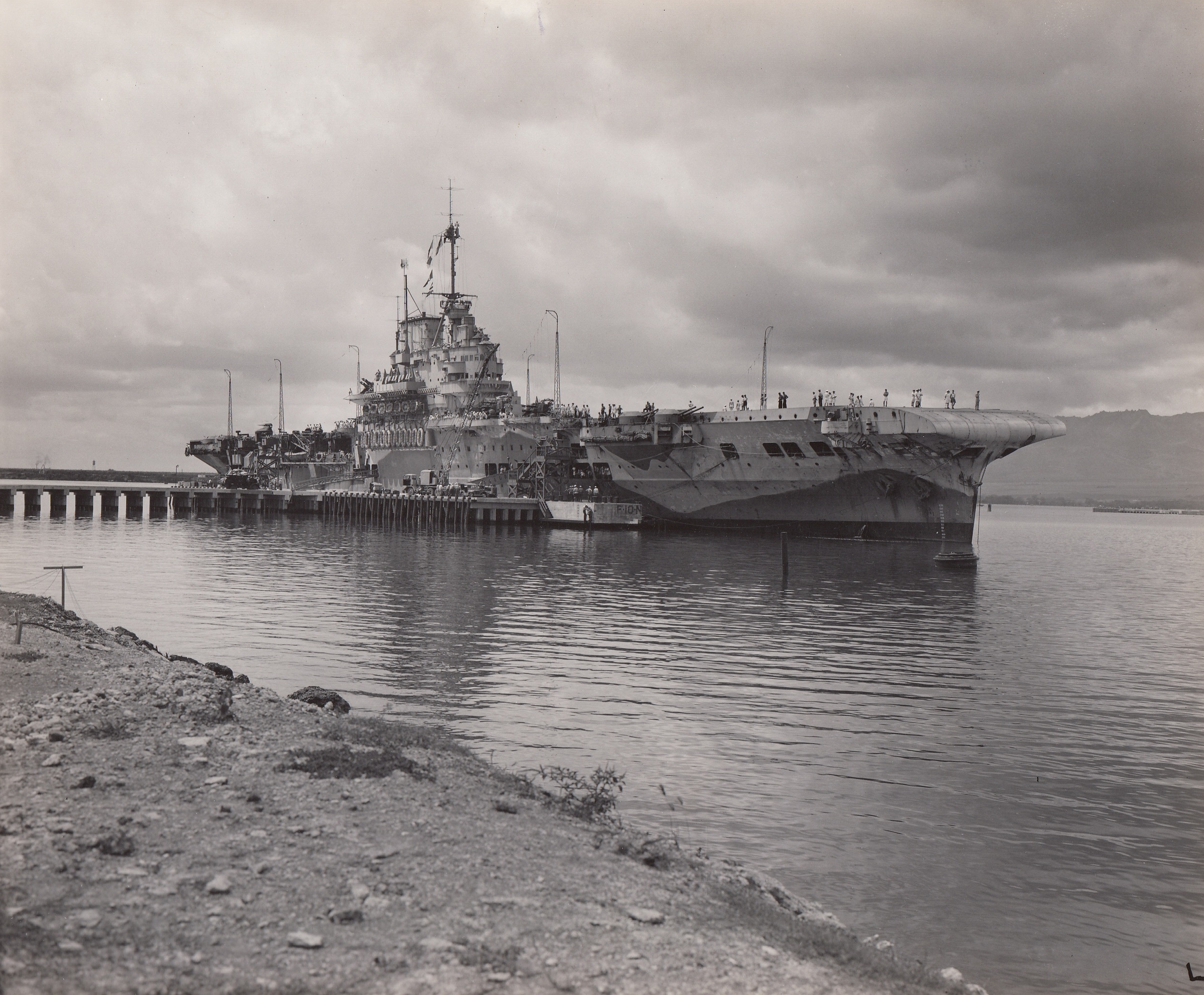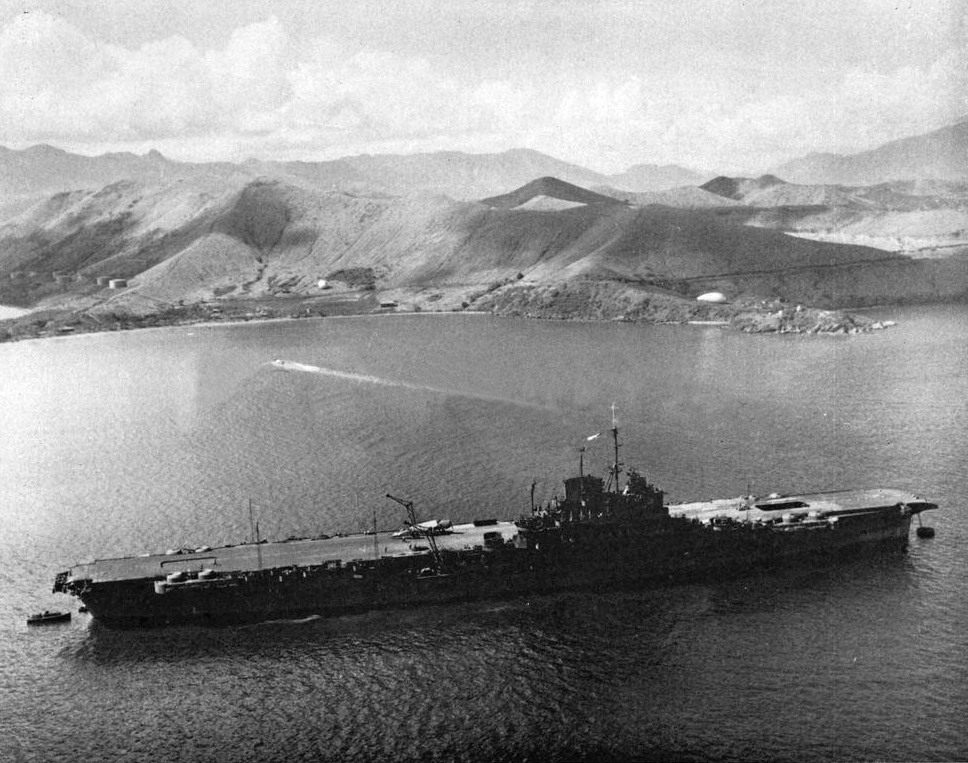South Pacific:
USS Robin (Part Two)
by Mike Bennighof, Ph.D.
November 2024
 Victorious arrived at Pearl Harbor on 4 March, continuing to exercise her air and anti-aircraft crews during the voyage. More Avenger landings proved that the British arrestor system simply could not handle the huge brutes. The carrier went into dockyard hands again at Pearl Harbor to receive another set of new arrestor wires, additional 40mm and 20mm anti-aircraft guns, and a coat of U.S. Navy battleship-gray paint outside and fireproof paint inside. Victorious also received a Coca-Cola dispenser and three ice-cream machines. “Ice cream is always available in large quantities,” Mackintosh reported to the Admiralty in a description of American practices, “and is much appreciated and is looked upon as essential.” Rugs, carpets, and potentially flammable furniture all had to go. Victorious arrived at Pearl Harbor on 4 March, continuing to exercise her air and anti-aircraft crews during the voyage. More Avenger landings proved that the British arrestor system simply could not handle the huge brutes. The carrier went into dockyard hands again at Pearl Harbor to receive another set of new arrestor wires, additional 40mm and 20mm anti-aircraft guns, and a coat of U.S. Navy battleship-gray paint outside and fireproof paint inside. Victorious also received a Coca-Cola dispenser and three ice-cream machines. “Ice cream is always available in large quantities,” Mackintosh reported to the Admiralty in a description of American practices, “and is much appreciated and is looked upon as essential.” Rugs, carpets, and potentially flammable furniture all had to go.
Lacking American coins for the Coke machines, the resourceful British sailors solved the problem with crowbars. They could not solve their rum shortage so easily. The U.S. Navy, a dry service since 1914 (when Secretary of the Navy Josephus Daniels, a temperance enthusiast and virulent racist even by the standards of his day, banned booze aboard Navy ships), did not provide alcohol to its men and showed little interest in helping their allies do so. British supply officers bought up 290 gallons of rum in Norfolk from civilian liquor stores, and another 200 gallons in Hawaii. While alcohol was not rationed in the United States, sugar was strictly limited and distilleries had reduced their output. In the South Pacific, the Royal Australian Navy stepped in to provide for the needs of the British carrier.
Those rules applied to the carrier and all who served upon her. The American liaison staff and the fighter pilots of VF-3 had full access to the bar in the officer’s mess of Victorious, but the British pilots of 832 Squadron aboard Saratoga had to make do with Coca-Cola or coffee.

Another view of Victorious at Pearl Harbor, March 1943.
Mackintosh, one of the few British carrier commanders with flight experience - he had served as a Fleet Air Arm observer - insisted on rigorous training for his aircrew. Because the Americans often used cross-deck deployments where planes from one carrier would land on another, Victorious had to use the same landing procedures as American ships. American deck crews used a different signaling system and confusion could prove deadly; for example, British and American batsmen (the crewman using brightly-colored paddles to wig-wag landing instructions to the incoming pilots) used the same signal for “Go Higher” and “You Are Too High,” respectively. A Royal Navy batsman had authority over the pilot during landing procedures and could tell him what to do including waving off a landing attempt; a U.S. Navy batsman merely relayed positioning information with final decisions in the pilot’s hands.
Victorious would operate one torpedo squadron of 16 planes and three fighter squadrons of a dozen planes each in American service. While part of Home Fleet she had flown one 18-plane torpedo squadron and two 12-plane fighter squadrons. The Avenger aircrews proved the most troublesome. Many of them had flown the Albacores of 832 Squadron, but were new to the Avenger. Others had been sent to the United States to train on the Avenger, but some of these men were not carrier-qualified when first assigned to Victorious. They had trained at Norfolk, but Mackintosh remained dissatisfied and asked for more time to practice.
For the next two months the aircrew trained in American methods, while the anti-aircraft gunners and damage control personnel underwent intensive training as well. Along with the battleship North Carolina, Victorious and her three destroyers left Pearl Harbor on 8 May, arriving in the war zone at Noumea on New Caledonia nine days later.

Victorious (right) and Saratoga together at Noumea, New Caledonia.
Seven months had passed since the American request for a British carrier, yet the situation had not markedly improved. Enterprise had been retained in the South Pacific despite her damage, with canvas sheets replacing destroyed bulkheads, and the proud carrier limped about trying to counter suspected Japanese moves. When Victorious set out from Pearl Harbor to Noumea, Enterprise steamed from Espiritu Santo for Pearl Harbor, before moving on to Puget Sound for major repairs. The new carrier Essex left Norfolk in May 1943 as well, bound for Pearl Harbor, but would not become fully operational until mid-summer.
That left Saratoga as the lone carrier in the South Pacific, the centerpiece of DeWitt Ramsey’s Task Group 36.1. Victorious joined the task force just in time to sortie in response to a report of a Japanese move of their fleet from Truk to the Solomons, which turned out to be a false rumor.
During the deployment, Ramsey noticed difficulties in coordinating his two carriers, and took them back out for much of June for exercises. As Saratoga’s skipper up until August 1942, Ramsey appreciated the British carrier’s superior fighter direction, but found the handling of her torpedo squadron less impressive. After intensive cross-decking exercises, Ramsey concluded that the smaller British ship simply could not handle the big planes efficiently, and directed that the British torpedo bombers of 832 Squadron move to Saratoga, while a dozen Wildcats the American fighter squadron VF-3 shifted to Victorious.
Saratoga retained the other half of VF-3, but otherwise became the task force’s strike carrier, while Victorious would serve as the fighter carrier. That relieved the British ship of dealing with the ponderous Avengers, and made best use of her sophisticated fighter direction capabilities. She would now operate 60 fighters, a substantially larger air group than ever before; her own planes also received American roundels to match those of Saratoga’s air group.

Victorious refuels from Cimarron in the approved abeam alignment.
The two carriers covered the New Georgia landings in June and July 1943, staying at sea for 28 days. Their aircraft did not provide direct support, but did defend the invasion convoy from Japanese air attacks; the British made no contacts with Japanese planes but their carrier and squadrons performed well. Victorious had rarely refueled at sea, something the Americans did regularly and the British only seldom. After some failed attempts at the standard abeam configuration the British carrier had to be fueled from the astern position, a minor humiliation for her crew. She did eventually manage to hook up abeam of the fleet oiler Cimarron, finally satisfying her captain, Mackintosh.
After four weeks at sea, the carriers returned to Noumea on 25 July. With new Essex-class fleet carriers and Independence-class light carriers now reaching the Pacific theater, the U.S. Navy no longer had such a desperate need for British assets. Victorious departed Noumea for Pearl Harbor on 31 July, taking with her 52 Saratoga crewmen bound for home and two Japanese prisoners of war. She and her escorts - the battleship Indiana and three destroyers - reached Pearl Harbor on 9 August. She refueled, disembarked the 33 men of her American liaison staff, and took on a matching 33 others bound for San Diego. She reached Norfolk on 1 September, where dockyard workers removed her American communications gear and repaired damage incurred in the Panama Canal. Re-equipped with new American-made aircraft, she returned to Britain on the 26th and promptly began a fresh refit that lasted until March 1944.
Despite deploying for just one month of active service, Victorious had steamed more continuous miles (12,233) than any Royal Navy carrier. During her three months in the Pacific, she covered 23,000 miles and landed aircraft 2,101 times. She lost six planes to accidents, but none to enemy fire; she and her aircraft did not engage the Japanese at all. Victorious returned to fight the Japanese in July 1944, seeing much more action as part of the British Pacific Fleet.

Another view of Victorious at Noumea, New Caledonia.
After all of the effort poured into preparing Victorious for her South Pacific deployment, she conducted just one combat mission, though it was an extended one. She needed a full month at Norfolk to prepare, another full month to transit to Pearl Harbor, two months at Pearl for more refitting and aircrew training, two months to return to Britain and six months of yard work there. All told, the deployment required one solid year of travel and overhaul in exchange for a one-month combat deployment covering the New Georgia landings.
That became something of a pattern for the famous carrier, which underwent an eight-year reconstruction to operate jet aircraft in exchange for nine more years of Cold War service life. As part of a service-wide cost-cutting spree she was decommissioned in 1967 (just after completing a six-month refit) and broken up in 1969.
Click here to join the Gold Club.
See your Gold Club Insider newsletter for ordering information.
Sign up for our newsletter right here. Your info will never be sold or transferred; we'll just use it to update you on new games and new offers.
Mike Bennighof is president of Avalanche Press and holds a doctorate in history from Emory University. A Fulbright Scholar and NASA Journalist in Space finalist, he has published a great many books, games and articles on historical subjects; people are saying that some of them are actually good.
He lives in Birmingham, Alabama with his wife, three children, and new puppy. He misses his lizard-hunting Iron Dog, Leopold.
Daily Content includes no AI-generated content or third-party ads. We work hard to keep it that way, and that’s a lot of work. You can help us keep things that way with your gift through this link right here.
|
